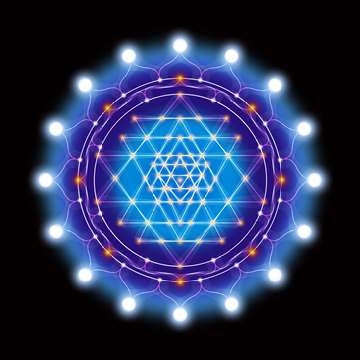Lalita sahasranama is a sacred Hindu text for the worshippers of the Goddess Lalita Devi, i.e. the Divine Mother, in the form of her and the male gods' feminine power, Shakti. Lalita is the Goddess of bliss, an epithet for Parvati. Etymologically, "Lalita" means "She Who Plays". It is supposedly one of the most complete stotras, one need only recite it to gain total salvation.
The names are organised as in a hymn, i.e. in the way of stotras. This hymn occurs in the Brahmanda Purana. It is a dialogue between Hayagriva, an (avatara) of MahaVishnu and the great sage Agastya.
Lalitha sahasranama was composed by 8 vaag devis (vaag devathas) upon the command of Devi Sri Lalitha. The 8 vaag devis are - Vasini, Kameshwari, Aruna, Vimala, Jayinee, Modhinee, Sarveshwari, Koulini. This depicts us the truth "One can worship Lalitha only if she wishes us to do so".
The slokas are organised in such a way that, Devi is described from "Head to Feet" (kEsAdhi pAdham).
Lalita Sahasranamam is held as a sacred text for the worship of the Divine Mother, Lalita, and is also used in the worship of Durga, Kali, Lakshmi, Saraswati, Bhagavathi, etc. It is a principal text of Shakti worshippers. Lalita Sahasranama names the various attributes of the Divine Mother, and all these names are organised in the form of a hymn. This Sahasranama is used in various modes for the worship of the Divine Mother. Some of the modes of worship are parayana (Recitations), archana, homa etc
he sloka is organised based on the 5 works (pancha kruthyam). They are - shrishti (Creation), sthithi (Protection), samhAram (Destruction), thirOdhAnam (Hiding) and anugraham (Blessing). Devi herself has been described as "pancha kruthya parAyanA" in the sloka and the five tasks are described as follows:
shrishtikarthree brahmma roopA gOpthree gOvinda roopini samhArinee rudra roopA thirOdhAnakareeswari sadAsiva anugrahadhA panchakruthya parAyanA
This means - Devi is doing shrishti as Brahmma, sthithi as Vishnu (Govinda), samhara as Rudra, thirodhanam as Eeswara and anugruham as Sadasiva.
This 5 entity (Brahmma, Vishnu, Rudra, Easwara and Sadasiva) are known as "pancha brahmmam". Lalitha has designated the five functions to these brahmmams. Sometimes, Devi will take away the life from these 5 brahmmam and make them inactive, performing all the 5 tasks by herself. At that time they will be called "pancha prEtam" that is life less bodies.
Now the first three slokas are: sree matha - (Great mother) Shrishti sree maha ragnee - (Great ruler)Sthithi sree math simhasaneswari - (One who sits on the simhasanam and manages) Samharam. Here there is no direct reference to samharam. But managing here includes, creating balance between birth and death.
The rest of the slokas cover - thirodhanam and anugraham.
Now the next namas - "chidhagnikunda sambhootha devakarya samudhyatha" tells us that devi arose from the fire of knowledge to help devas in their task (war against asuras - bandasura).
From the namAa- Udhyath bhanu sahasraba till sinjanamani manjeera manditha sree padambuja, all her parts like her face, fore head, eyes, mouth, tongue, voice, hands, hip, legs has been described.
Thereafter, Devi's place (Chintamani gruham), her war against bandasuran, kundalini shakthi, her properties (like who can reach her and who cannot) etc has been described.

